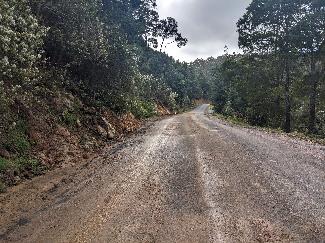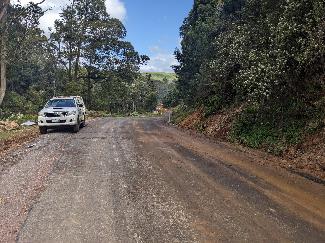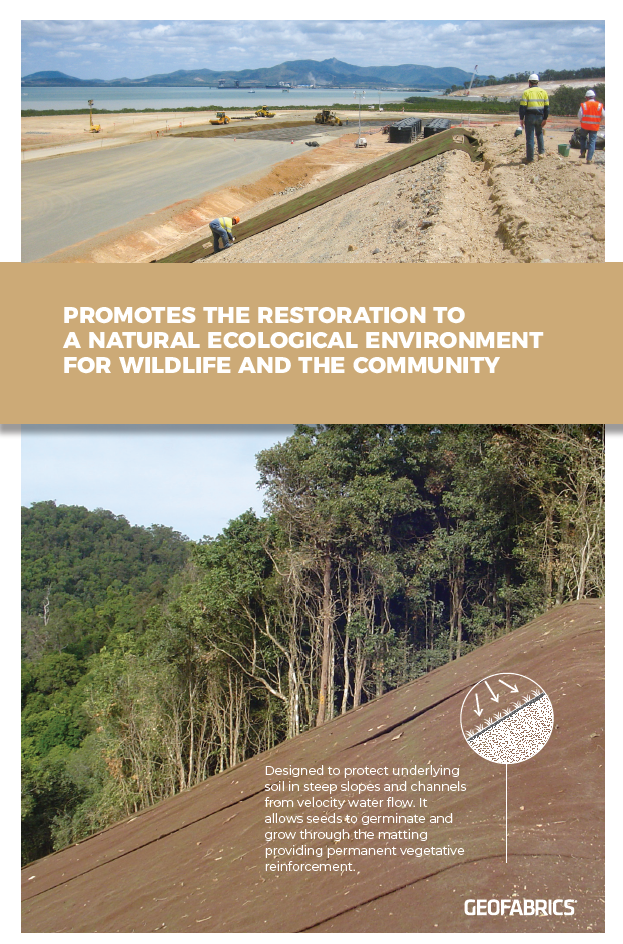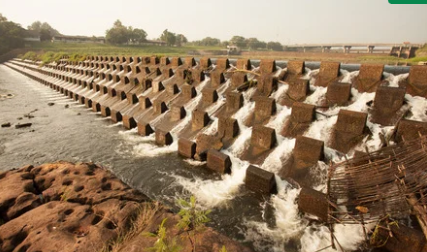06 December 2023
Contractor Harding’s Hotmix have almost completed the main drain dig out from the top to the road. This drain will take the water that once sat in the illegal dams away from the landslip zone and into the creek.
The final design of the road crossing is being worked on to balance suitable design and minimise disturbance to local residents.
The cut down to the road that will be piped & backfilled
Location of where the old upper dam was
20 November 2023
Harding Hotmix have completed the decommissioning of the two dams above Upper Natone Road, with works commencing on the top drain.
Traffic control is still in place with the single lane in operation.
Decommissioning of the two upper dams
02 November 2023
Harding Hotmix are continuing with the complex drainage works, alongside decommissioning the two dams above the road. The Spring weather has allowed our teams to increase the verge clean ups areas, allowing for a longer stretch of road.
Verge Clean ups. Providing longer stretch of road
27 October 2023
- Batter failures and verge clean ups have been completed providing a longer stretch of 2 lane road
- One Lane road is still in use through the main slip zone in front of 512 Upper Natone Road
- Natural Value studies have commenced in the creek to determine best practice during civil works
- Harding’s have commenced drainage works near the top dam


Verge clean ups underway, providing a longer stretch of 2 lane road
20 October 2023
GeoTon have completed test holes on top of the main road cut batter, to determine how deep the slip plane is for batter design.
Hardings will commence work on Monday 23 October 2023. They will:
- Clean up the inside verges to allow two way traffic for a longer stretch
- Install new traffic control centred around the driveway – one lane
- Start drain & decommissioning dam works from the top dam
- General shape will be 3m wide trench (Excavator tracks) and side batters to suit stability
- From the top dam to lower dam it will be lined with Grassroots to prevent erosion
- Subsoil drains will be installed with no return valves and exit into the drain
- Both Dams will be decommissioned
From the lower dam down to the road it is still undecided on the best approach. A similar trench will be cut to start with to determine what site conditions are. Options for this section include:
- Reno Mattress
- Pipe if no subsoil drainage issues are found
- Mesh & Shot Crete if ground conditions are suitable
- Dissipation methods
- Box Culvert crossing the road
Surveyors have options ready once they know what they are dealing with, but they won’t know what they are dealing with until they get in there.
The preferred road repair solution is to pipe the creek and move the road onto the top of it. Hardings will cut a track into the creek on Tuesday 24 October. GeoTon and Natural State will be onsite to inspect ground conditions for suitability and conduct a Natural Values Report. Once the surveyors have gathered all the information from Tuesday, a proposal will be developed.

Grassroots® is made in Australia from heavily UV stabilised synthetic fibres which are needle-punched together into an open weave three-dimensional structure, designed to offer a permanent engineered solution that assists the establishment of vegetation even in extreme environmental conditions.
11 October 2023
Clearing was created for the proposed drainage channel, with drainage works from the Upper Dam to the road crossing commencing from the last week of October.
Please note: Access issues have caused delays in the works, despite access to the site being granted.
Road design alternatives are being considered to keep the road open during the repair works.
The site for the drainage channel has ben cleared
28 September 2023
Initial site works began the second week of September 2023 around the dams (above Horseshoe Bend) to determine drainage path & depths. The delay in being able to begin the remediation works has been due to obtaining access to this private property. Both dams contributed significantly to the ground saturation which is a major factor in the landslip issues.
Test holes have been dug around these existing dams and have determined that the ground water is up to 4.5m deep. This water needs to be intercepted by the new drain to stop the ground saturation. Both dams have contributed significantly to the ground water issues due to no spillways and extremely poor construction. Therefore, both dams will be decommissioned.
Having gained direct access, we have now determined the best modelling for the final drainage required. Hardings have been engaged and will begin to build the drain in the coming weeks.
Our engineers on site will be continuing to decommission the dams over the next 3 to 4 weeks.
Above: Drainage Plan
Saturated soft clays within landslide area
Saturated soft clays within landslide area
Test Pit along drainage path
Friday 8 September 2023
Friday 14 July 2023
Consultant engineers are 80% complete for the final drainage plans. Drainage works will need to include flexible energy dissipating drain systems in order to control the vertical water flow properly. This will eradicate destructive impacts of water flow, due to the elevation.
Example of a flexible energy dissipating drain system diagram

Example of a large flexible energy dissipating drain system. Reduce the pressure of water from the dam.
Council are also awaiting permission from local land owners, in order to gain access to begin the first stages of the remediation works.
We are committed to investing $7.5 million dollars provide by both State Government funding and Burnie City Councils renewal contribution to the project.
Thank you so much for the community’s patience and the positive responses we have received, as we continue to work hard for you on what we know is a huge issue in your area.
Thursday 25 May 2023
Consultant engineers are near completion of the final drainage plan. Concepts for road works have been submitted for review. Drainage works are proposed to as soon as possible with road reconstruction work to commence after winter.
Friday 12 May 2023
Remediation plans and designs for Horseshoe Bend road are still progressing.
Thank you so much for the community’s patience and the positive responses we have received, as we continue to work hard for you on what we know is a huge issue in your area.
Friday 5 May 2023
Remediation plans and designs for Horseshoe Bend road are still progressing.
Friday 28 April 2023
Assessment and remediation plans for Horseshoe Bend road reconstruction is continuing. Due to the design being quite intricate, this process will take further time to complete to ensure the absolute prolonged safety of road users.
Friday 21 April 2023
Assessment and remediation plans for Horseshoe Bend road reconstruction is continuing.
Friday 14 April 2023
Design work is continuing on road reconstruction to re-establish the current road location.
Friday 7 April 2023
Design work is continuing on road reconstruction to re-establish the current road location.
Friday 31 March 2023
The final design for the drainage work on Horseshoe bend has been completed. The implementation of the drainage remediation work will begin prior to the road reconstruction.
Friday 24 March 2023
Design work is continuing on drainage and road reconstruction to re-establish the current road location.
Friday 17 March 2023
Design work is continuing on drainage and road reconstruction to re-establish the current road location.
Friday 10 March 2023
Investigation and evaluation work is now complete. The investigation included assessment of the subsurface conditions, possible causes for the failed section of road, remediation recommendations and geotechnical parameters for pavement designs.
Image 1: Proposed Remediation Plan
The preliminary concept design has been proposed. Geotechnical engineers have recommended to re-establish the current road location due to the alternative investigated routes deemed unfeasible (refer to image 2 and 3).
Image 2 – Route 1 (Red Route)
Image 3 – Route 2 (Blue Route)
Image 4 – Existing Road Layout
EXISTING ROAD LAYOUT
- The existing road alignment is located near the bottom of the hill and follows the contours relatively closely. This reduces steep grades and excessive cut/fill quantities.
- Geometrically the road complies with the relevant standards.
- Although extensive works are required to secure the landslide areas, this route is the preferred option when considering the alternatives.
Design work has commenced on drainage and road reconstruction and is expected to take up to six weeks to complete.
Friday 3 March 2023
Horseshoe Bend will remain restricted to one lane of traffic with a 5 ton load limit until further notice, as design work to determine the most suitable restoration solution is still ongoing.
Friday 24th February 2023
Work is continuing to determine the best long-term recovery options.
No new information is available at this stage.
Thank you so much for the community’s patience and the positive responses we have received, as we continue to work hard for you on what we know is a huge issue in your area.
Extension of Private Landowner Clean-up and Restoration Grant
(separate to the Tasmanian Recovery Funding)
Private landowners or leaseholders that have suffered direct damage from the severe weather event on 13 and 14 October 2022 can apply for a Private Landowner Clean-up and Restoration Grant to help pay for the costs of cleaning up debris and repairing damage on their property.
����♀️ NEED SOME HELP?
If you have trouble with the application form, or if you have any questions about the application process, call the Community Grants Unit on 1800 204 224 or email grants@dpac.tas.gov.au
Friday 17th February 2023
Work is continuing to determine the best long-term recovery options.
No new information is available at this stage.
Friday 10th February 2023
Council has received a number community requests to open the width of the lane and to increase the load limit. The latest Geotechnical engineering advice recommends that due to ongoing concerns regarding the subsurface stability, it is essential that the current restrictions remain in place for the public's safety.
Work is continuing to determine the best long-term recovery options, including exploring an alternative route.
Friday 03rd February 2023
Our geotechnical consultants received lab testing results for the Upper Natone landslip on Monday, 16 January 2023 which will guide any potential repair work.
Findings to date:
- The subsurface conditions within the landslide effected area of the road typically consists of clayey silt landslide deposits to depths of 1.0m to 4.0m, overlying residual clays and clayey sands (granite derived) to the investigated depths of 10.7m. Bedrock was not encountered in the investigation.
- Landslide deposits have pushed out into Paton Creek. There is a 1.5m vertical step of soil along the western bank of Paton Creek.
- Monitoring surveys since the current traffic management of single lane and 5 tonne limit have shown no signs of movement along the road.
- Repair work to Horseshoe Bend will involve major civil construction work, potentially including concrete piers.
- Three alternate routes are currently under investigation, each with their own specific challenges.
Friday 27th January 2023
The Geotechnical engineers alongside Burnie City Council are continuing to examine drainage and road reconstruction plans that were presented to council, and communicated with the community last week.
3D Lidar mapping and site monitoring surveys are continuing, in order to achieve all potential advantages and disadvantages of alternative routes.
3D Lidar mapping continues
Friday 20th January 2023
Geotechnical drilling has been conducted within the landslide effected area of the road. Several boreholes have been drilled with temporary groundwater monitoring wells installed. The initial boreholes and further observations indicate/confirm the following:
- The landslide effected area within the road typically consists of basalt derived landslide deposits, overlying residual granite derived clays
- The interface between the basalt derived landslide deposits and the residual granite clays is soft and saturated and interpreted as being the slip plane of the landslide feature.
- The interpreted slip plane in this area is located at a depth of approximately 1m to 4m below the road.
- The subsurface conditions within the landslide effected area of the road typically consists of clayey silt landslide deposits to depths of 1.0m to 4.0m, overlying residual clays and clayey sands (granite derived) to the investigated depths of 10.7m. Bedrock was not encountered in the investigation.
Remediation Options
Drainage Works
Drainage works are required to be completed before any reconstruction of the road is undertaken. Once the drone survey is complete a drainage plan can be completed. The drainage remediation works will likely consist of the following:
- A rock lined drainage channel to collect surface flows from the dam inundation area while also intersecting additional downhill springs. The rock lined drainage channel will discharge into an appropriately sized culvert beneath Upper Natone Road (see attached plan). The size of the culvert/drainage channel will be determine by the catchment area and will be able to calculated once the drone survey has been completed. The drainage to be designed to pass at least 1 in 100year storm event;
- Install surface cut-off drains above the recent landslide features and existing road cut batters
- Possible drainage work above the landslide feature to reduce the catchment area (i.e. spoon drains to divert water away from the landslide effected area and current dam catchment area).
- Possible horizontal direction drill deep dewatering drains (intersect and drain subsurface water along the interpreted slip plane). These may not be required if the initial drainage works significantly reduces the subsurface groundwater within the area and no significant movement has been recorded within the inclinometer.
Drainage works will aid in stabilising the larger deep seated landslide, whereas structural support systems/retaining walls will be required for shallow slope stability issues.
Road Repair
Once the drainage works and slope stability modelling has been completed the road repair options will be finalised. Based on the current observations and encountered subsurface conditions possible road repair options are as follows (or a combination of the below options depending on the depth of the landslide deposits):
- As the interpreted slip plane has a relatively shallow dip angle within the uphill side of the road, an option is to cut the road back into the existing slope by approximately 2-3m. This will ensure the base of the road is entirely on natural ground and not partially on fill. However, this option will remove some of the toe support of the landslide. As such, once the drone survey is complete the slope stability model will be finalised to determine the suitability of this option. The slope stability modelling will also determine the requirement for retaining of the uphill and downslope batters.
Shallow Remedial Works
- Rebuild the downhill lane with gabion baskets . The gabion baskets will need to founded within the encountered stiff/very stiff residual granite soils (i.e not the basalt landslide deposits) encountered at depths below 2m to 5m from the existing road level. The gabion baskets are suitably fully drained and will allow for some minor movement.
Deep Remedial Works
- A deep pier/piling wall which will likely require a socket depth greater than 10m (The depth to rock was not encountered with the boreholes terminated at the max depth of 10.7m). As such, a deeper investigation would be required using a bigger drill rig with coring capabilities to determine a suitable founding depth; and
- The pier wall will need to stabilise the slope and minimise landslide movement. This is unlikely to be an option due to the size of the landslide.
This is a large active landslide and future movement is to be expected. However, if drainage works are to be completed then the likelihood of significant movement occurring in the future will be reduced. In addition, we consider that regardless of the remedial works undertaken, long term monitoring will be required.
Below are List Map plans showing the location of the recently added landslides to the MRT database. The map shows the following:
- The alternate road realignment (existing track) on the eastern side of the river also crosses/intersects a mapped landslide feature. This feature is directly adjacent to the main landslide we are dealing with along Upper Natone Road. The investigation has shown that the landslide extends further to the south and extends beneath Upper Natone Road.
- The alternate road realignment is predominantly mapped within a medium landslide hazard band
- The geology setting on the eastern side of the river is the same as the western side (i.e. basalt plateau overlying granite).
Due to the slopes on the eastern side of the river having the same geology setting, in addition to a mapped landslide feature, an extensive geotechnical investigation would be required to determine the suitability/stability of this area.
Friday 13th January 2023
Monitoring surveys are continuing to be conducted to record if any movement is still present with in the slip zones.
PDA Surveyors are conducting comprehensive surveys over the existing alignment using LiDar drones. The LiDar drones assist in investigating possible alternative routes, establishing the feasibility of the proposed options.
Geotechnical Engineers are still working through the findings from the core samples taken, and Burnie City Council and Engineers are awaiting results.
Friday 06th January 2023
Please be advised that due to the Christmas break period, further updates will become available next Friday (13/01/23) upon the return of contractors, technicians and Geotechnical engineers.
One lane of traffic continues to remain open with a load limit of 5 tonne. We appreciate the community's assistance in keeping the temporary traffic management that has been installed (flagging, pickets and signage) in place, for the publics safety.
Thank you so much for the community's patience and the positive responses we have received as we continue to work hard for you on what we know is a huge issue to your area.